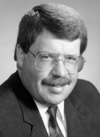 Wisconsin Lawyer
Wisconsin Lawyer
Vol. 79, No. 8, August
2006
Screen Transferring Lawyers for Conflicts
A new proposed Rule of Professional
Conduct for Attorneys may help to avoid conflicts of interest when
lawyers transfer between law firms. The rule permits a new firm to
"screen" a lawyer transferring from another firm from any contact with
members of the new firm who are involved with litigation pending between
the two firms.
by Dean R. Dietrich
The Wisconsin Supreme Court is considering final changes to Chapter
20, the Rules of Professional Conduct for Wisconsin Lawyers. The first
draft of the proposed rules includes changes that involve the screening
of a lawyer who transfers from one law firm to another law firm if both
of the law firms are involved in litigation against each other on behalf
of clients. This notion of "screening" a lawyer who transfers from one
law firm to another law firm is found in proposed SCR 20:1.10 and is a
new concept in Wisconsin.
 Dean R. Dietrich, Marquette 1977, of Ruder Ware,
Wausau, is chair of the State Bar Professional Ethics Committee.
Dean R. Dietrich, Marquette 1977, of Ruder Ware,
Wausau, is chair of the State Bar Professional Ethics Committee.
The Proposed Rule
The new rule proposed in SCR 20:1.10 is:
"(a) While lawyers are associated in a firm, none of them shall
knowingly represent a client when any one of them practicing alone would
be prohibited from doing so by Rules 1.7 or 1.9 unless:
...
(2) the prohibition arises under Rule 1.9 and
(i) the personally disqualified lawyer performed no more than minor
and isolated services in the disqualifying representation and did so
only at a firm with which the lawyer is no longer associated;
(ii) the personally disqualified lawyer is timely screened from any
participation in the matter and is apportioned no part of the fee
therefrom; and
(iii) written notice is promptly given to any affected former client
to enable the affected client to ascertain compliance with the
provisions of this Rule."
The Concept Behind the Rule
The rationale behind the rule change is to allow certain lawyers who
are in one law firm to transfer to the other law firm without the other
law firm being required to remove itself from the litigation on behalf
of its client. The concept behind the rule change is that the
transferring lawyer may become employed by the new law firm if notice is
given to the old law firm (and its client) of the transfer and of the
commitment by the new firm to "screen" the lawyer from any contact with
members of the new firm related to the pending litigation. Under the
concept of screening, the transferring lawyer may not have any
discussions with members of the new law firm about the pending
litigation and must be removed from any access to information or files
related to the pending litigation.
An important aspect of the screening rule is that it only applies to
certain lawyers who may transfer from one law firm to another law firm.
A lawyer who has primary responsibility for litigation in the old law
firm that has a conflict with the new law firm may not transfer to the
new law firm and expect the screening rule to apply. The screening
process may only be used for lawyers who have had minimal contact with
the litigation that creates the conflict of interest for the lawyer
transferring to the new law firm. Whether or not a screening process can
be used for a particular lawyer transferring to a new law firm will
depend on the facts of the litigation and the involvement of that lawyer
in the litigation when employed by the original law firm.
While the screening rule in SCR 20:1.10, as proposed, is subject to
varying interpretations, it provides an opportunity for attorneys to
transfer among law firms in an environment where lawyers have a tendency
to move from one law firm to another. Protections remain for the clients
because this screening provision only applies to limited circumstances
in which the lawyer seeking employment with a new law firm has not been
intimately involved in the litigation on behalf of the client in the
original law firm. Clients also are protected because notice of the
screening arrangement established by the new law firm must be given to
the original law firm and the client. This affords the original law firm
and its client the opportunity to challenge the continued representation
by the new law firm through a motion to disqualify that law firm.
The Wisconsin Supreme Court will be giving final consideration to
proposed Rule changes in September. It is anticipated that the court
will issue a final draft of the changes to Chapter 20 in September or
October with an effective date of either Jan. 1, 2007, or July 1, 2007.
To obtain more information about and to read the full draft of the
proposed Rule changes, please visit www.wisbar.org/ethics2000.
Wisconsin Lawyer
